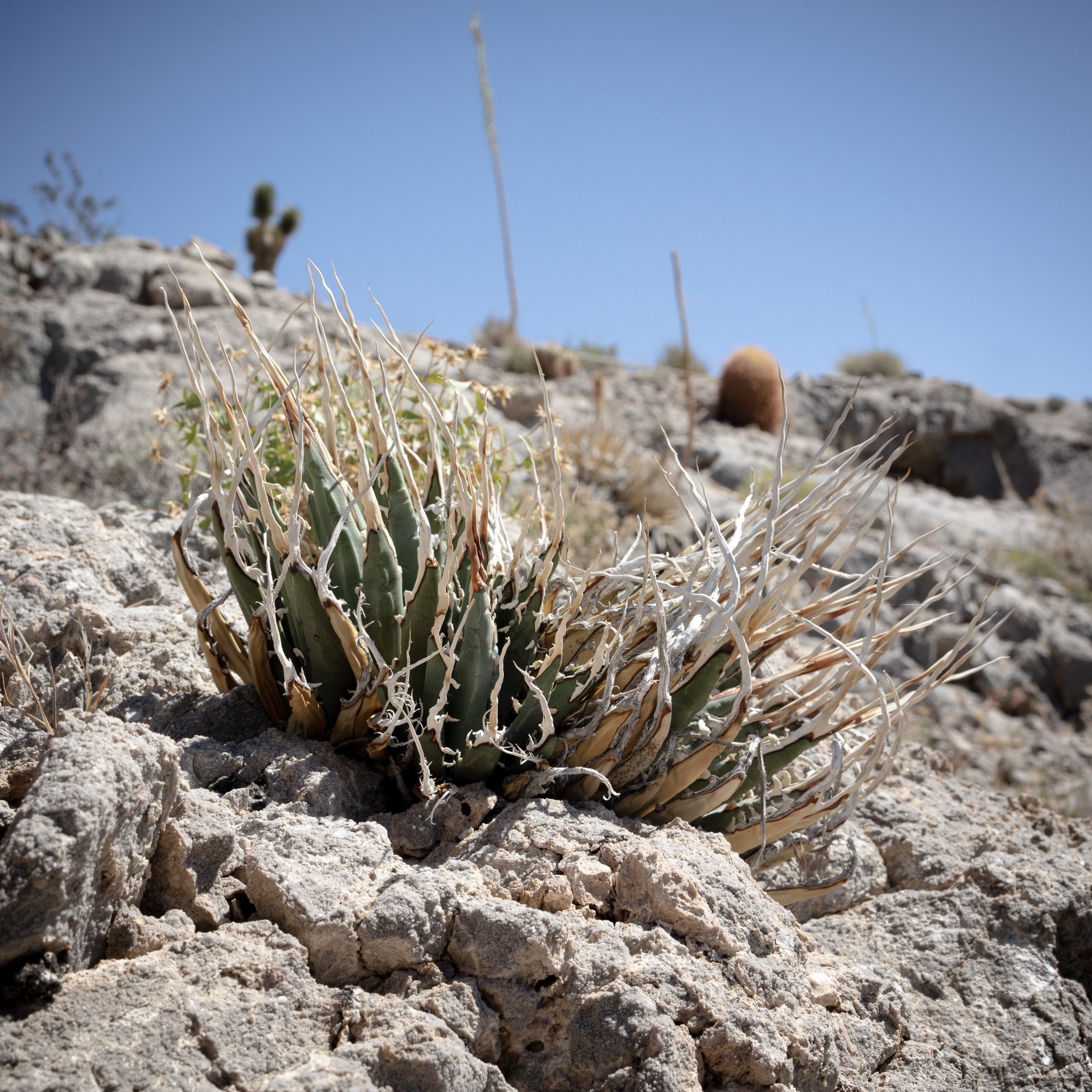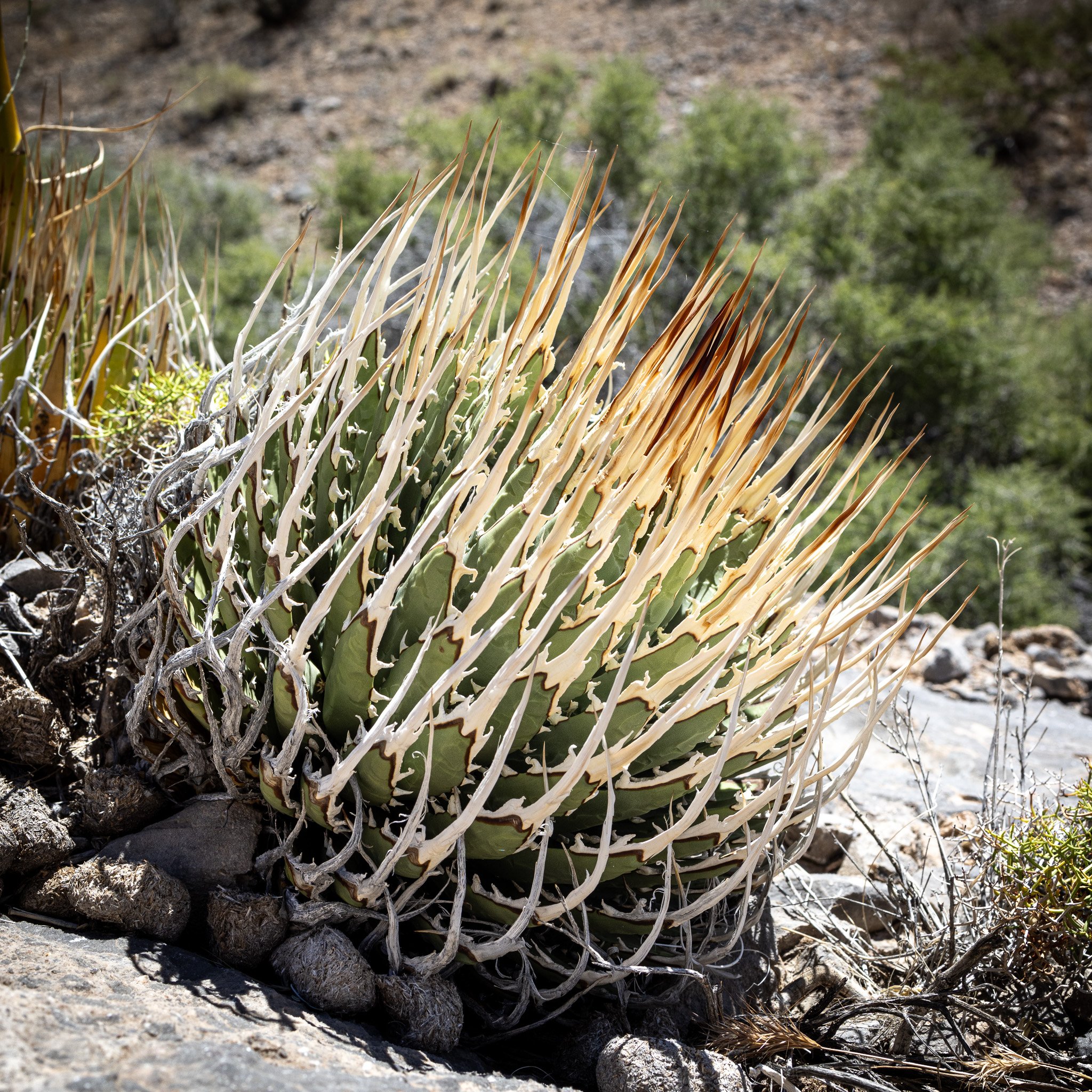Field Notes
I’ve spent years exploring the the Mojave Desert around Las Vegas, trail running, rock climbing, off-road adventuring and hiking amongst the amazing flora and fauna of the region. The Spring Mountains, a sky island thousands of feet above the valley floor to the west of Las Vegas, has become my favorite place on earth and is the heartland of agave utahensis varieties nevadensis and eborispina. This landscape is also dotted with archeological sites like roasting pits, rock art and lithic tool making debris, much of which speak to the relationship between various indigenous groups and agave utahensis, which go back thousands of years. Here on this blog I write about my observations, learnings and research about this incredible land and the agave that call it home.
You’re Being Lied to About Agave Utahensis var. Eborispina
There are sellers online, and in person, who are blatantly lying to you about the plants they’re selling. Do you know how to actually identify eborispina?
The Taxonomy of Agave Utahensis
The taxonomy—or categorization—of the four different kinds of Agave utahensis has changed over the years. And most of us still lean towards using the same taxonomy that Gentry used, including Agave utahensis subsp. utahensis var eborispina, and Agave uthaensis subsp. utahensis var nevadensis, generally shortened to Agave utahensis var eborispina and Agave utahensis var nevadaensis. In this article, I detail the history of the taxonomy of the species, and where it stands today.
Is Agave utahensis a succulent?
Is Agave utahensis a succulent? Can I grow it inside like I would my other succulents? Spoiler alert: yes, and yes.
Agave Utahensis: Read this before purchasing
Was that Agave utahensis you’re about to buy poached? Is the seller lying to you about it being eborispina? Do you know how to properly care for it? There are some really important things you need to know before you purchase an Agave utahensis.
Introducing ML.V 2: “Mojave Frost”
Blue agave utahensis v nevadaensis plants are my favorite. I particularly enjoy finding them covered in snow while hiking a ridgeline in the mountains. One of my seed batches consistently produces the palest and bluest glaucousness: M.LV 2, or Mojave Frost.
Are Agave Utahensis Clonal Rings Living Artifacts?
I'm honored to share that I've published a comprehensive 17-page paper with 52 citations in the Winter 2024 issue of the Cactus and Succulent Journal detailing the results of a survey I conducted of 96 different Agave utahensis clonal rings across three distinct sites in Southern Nevada, all located near archaeological roasting pits.
Does Agave Utahensis Make a Good Houseplant?
Agave utahensis is a collector’s favorite agave. But does it make a good houseplant for folks who aren’t (yet) agave nerds? I think it absolutely can, but there are a few things we need to be aware of about how it differs from other “traditional” houseplants.
10 Things You Didn’t Know About Agave Utahensis
There are so many interesting facts about agave utahensis. From it’s history, to it’s biology, to the research that will define it’s future. In this post, I’ll detail 10 facts you probably don’t know about agave utahensis.
Agave Utahensis and the Calcicole Problem
Agave utahensis is a calciphile plant. That means it prefers to grow on calcium-rich soils. The question of why certain plants exhibit calciphilic or calcifuge tendencies remains a subject of ongoing scientific investigation, likely involving multiple factors.
Ancient Agave Utahensis Roasting Pits
Archeological evidence shows that humans have lived in the Las Vegas area for at least 10,000 years and for much of that time, agave utahensis was an important food source. Evidence of ancient indigenous use of utahensis can be seen scattered throughout its range (especially in the Spring Mountains just outside of Las Vegas), in the form of roasting pits.
Why is Agave Utahensis v Nevadensis blue and Eborispina green?
Nevadensis is known to generally be more glaucous than the greener eborispina (and the rest of the species). One possible explanation for this is altitude. In my experience, Nevadensis is mostly found growing 1,000 to 2,000, or more feet higher than eborispina. I have recently heard reports of green plants above 7,000ft deep in eborispina’s range but have yet to personally confirm this.
History of Agave Utahensis
Humans have been using agave for more than 10,000 years, and cultivating it for thousands. In this article, I explain the history of the agave plant genus, the geological history that led to it’s spread, and how utahensis became it’s own species.
Potential Agave Utahensis Rock Art
Did I find pre-historic rock art depicting agave utahensis in the Spring Mountains? “BC” site is a protected archeological district nearly 3,000 acres big, in Red Rock Canyon at the feet of the Spring Mountains here in Las Vegas. It's a large complex of rock art, agave roasting pits, and water sources that has been used by Ancestral Puebloans, Southern Paiute, as well as historical groups.
Agave Utahensis Var Nevadensis vs Var Eborispina
There are four types of agave utahensis: ssp kaibabensis (which grows primarily in the area of the Grand Canyon), ssp utahensis (which grows in southern Utah, northern Arizona, southern California and southern Nevada), var eborispina, and var nevadensis. Eborispina and nevadensis only grow in Nevada and California, primarily in limestone soils around the Spring Mountains near Las Vegas.













